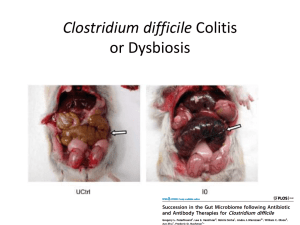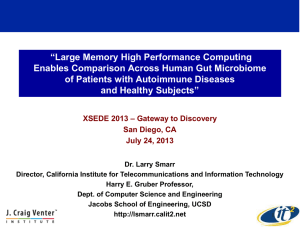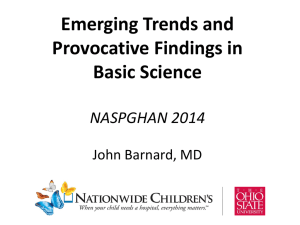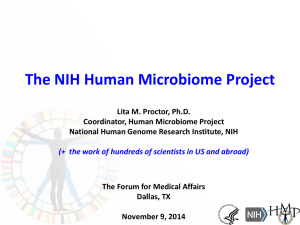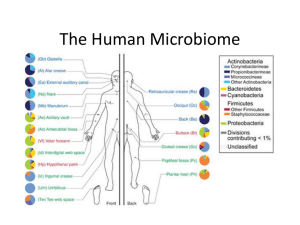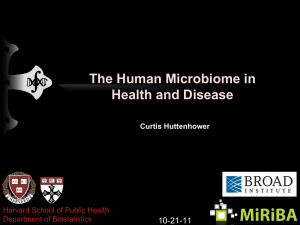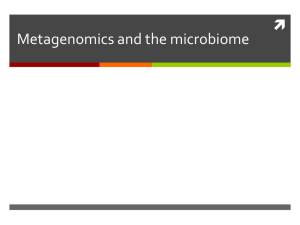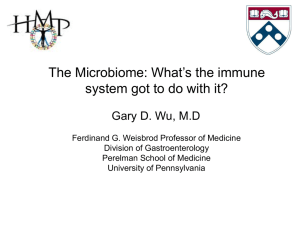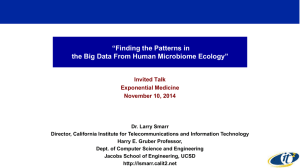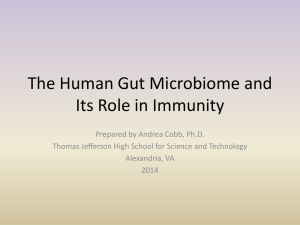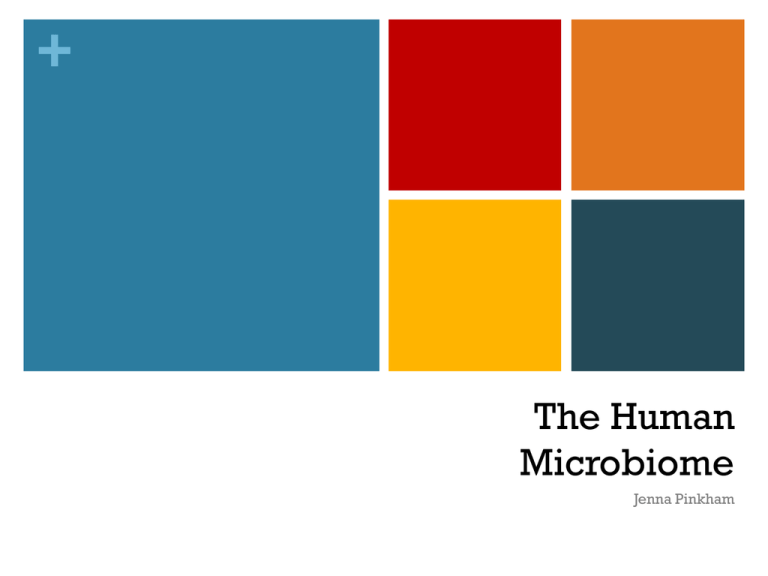
+
The Human
Microbiome
Jenna Pinkham
+
You are only 10% human
Bacteria, viruses, fungi, and various microbes cover
every inch of the surface of you body—skin, mouth,
sinuses, lungs, intestines, etc.
(Think of the body as donut-shaped: you have
surfaces on both the “outside” and the “inside”)
Each part of your body is like a different ecosystem
—your elbow skin is different from your finger
skin is different from your tongue…
Microbes outnumber your human cells by about
10:1
Everyone’s microbiome is unique to them
You couldn’t get rid of all your germs even if you tried
+
Not all bacteria are bad
The majority of the bacteria in/on your body are:
Commensals: “generally harmless freeloaders”
Mutualists: “favor traders”
Ex: bovine and termite gut flora
help their hosts break down
cellulose, which the hosts can’t
do on their own
Pathogens are bad—but your
own microbiome acts as a
defense against them
Competition for space and
resources
Mutualism: red-billed oxpecker eats ticks off an
impala’s coat
+
Mutualism
Immune function
Bacteria in our bodies
compete for resources just
like animals outside
compete
Mutualistic bacteria can
prevent invading microbes
from taking hold and can
even render an environment
inhospitable to foreigners
Can digest the foods we lack
the enzymes for
Provide 10-15% of our
calories
Manufacture of substances
Neurotransmitters
B-vitamins and K-vitamins
Important amino acids
Short-chain fatty acids
Signalng chemicals to
regulate appetite and
digestion
In return, we provide bacteria
with food and shelter
+
A healthy microbiome?
Still early in the research—scientists reluctant to describe what a
healthy microbiome looks like
Impoverished “Westernized microbiome” is distinctly different than the
microbiomes of rural Africans and Indigenous communities in South
America (some of which have had limited contact with the Western
world)
Core principles of ecology still hold
Diversity is good, as diverse ecosystems are more resilient than those with
relatively low biodiversity
Microbes fill specific niches within your internal ecosystem, making the
introduction of newer species difficult (but not impossible)
Environmental factors (diet, antibiotics) have a huge impact on population
levels
Very complex relationship between microbiome and host
+
What can influence your
microbiome
Diet
Processed foods (sterile)
Antimicrobials
Pesticides
Meat-based vs. plant-based
Diversity
Whether you were delivered
vaginally or via C-section
How many different people held
you as a baby
Whether or not you've recently
been on antibiotics
Sex hormones
How many times you’ve taken
antibiotics
The microbiome of your birth
mother
Certain medical procedures
Whether or not you were
breastfed
Radiation therapy
The presence of a family dog
+
Illnesses associated with an
specific microbiome populations
Autoimmune disorders
Diabetes
Celiac disease
Inflammatory diseases
Crohn’s disease and colitis
Asthma
Multiple Sclerosis
Obesity
Certain cancers
Autism
Kwashiorkor
Severe, deadly form of
malnutirion
Allergies
Heart disease
Infections
Clostridium difficile
Vaginal infections
Metabolic Syndrome
+
Future applications in health
More research is needed, and researchers are wary about
overstating the benefits that can be derived from learning to
manipulate the human biome
Still, manipulation of the microbiome has proved beneficial
in a number of cases
+
Fecal Transplants
Transplanting the microbiome from one organism to another
Really need a new name
Used in the treatment of C. difficile infections in humans
Fecal transplants in rats
Gut flora from human twins where one twin was obese and the other
thin were transplanted into genetically-identical rats born and kept in
a sterile environment. Mice given the gut flora of the obese twin
weighed nearly 20% more than mice given the gut flora of the thin
twin.
Mice then put in cages together, causing microbiome-sharing. When
fed a low-fat diet the gut flora of the fat mice were replaced with those
of the thin human twin, and the fat ones lost weight. When fed a highfat diet, the fat mice maintained the microbiomes of the obese human
twins.
+
Probiotics and Prebiotics
Probiotics: ingestible good-for-you bacteria (like in yogurt)
Prebiotics: substances that feed the good-for-you bacteria
Can be used to introduce bacteria into a microbiome lacking in a
specific species
Probiotic bacteria often do not stick around in your GI tract, but
may influence your microbiome though horizontal gene sharing
Can make your ecosystem more favorable to specific bacteria,
which can displace harmful ones and nurture microtomes in
children
Some scientists believe a combination of the two can be used
to deliberately alter people’s micro biomes to be more
beneficial to overall human health
+
Bibliography
Charles, Dan. "Gut Microbes May Play Deadly Role In Malnutrition." NPR.
NPR, 30 Jan. 2013. Web. 29 Sept. 2013.
Charles, Dan. "What Our Gut Microbes Say About Us." NPR. NPR, 9 May 2012.
Web. 29 Sept. 2013.
Karim, Muhammad Mahdi. An Impala at Mikumi National Park. 2008.
Photograph. Mikumi National Park, Tanzania.
Kolata, Gina. "Gut Bacteria From Thin Humans Can Slim Mice Down." The
New York Times. The New York Times, 5 Sept. 2013. Web. 29 Sept. 2013.
Pollan, Michael. "Some of My Best Friends Are Germs." The New York Times.
The New York Times, 15 May 2013. Web. 29 Sept. 2013.
Samsel, Anthony, and Stephanie Seneff. "Glyphosate’s Suppression of
Cytochrome P450 Enzymes and Amino Acid Biosynthesis by the Gut
Microbiome: Pathways to Modern Diseases." Entropy 15.4 (2013): 1416-463.
Print.
+
Bibliography (con’t)
Smif, Pete. Human Topology. Digital image. N.p., 22 Nov. 2007. Web. 29 Sept. 2013.
Spor, Aymé, Omry Koren, and Ruth Ley. "Unravelling the Effects of the Environment and
Host Genotype on the Gut Microbiome." Nature 9 (2011): 279-90. Web. 29 Sept. 2013.
<http://www.nature.com/nrmicro/journal/v9/n4/full/nrmicro2540.html>.
Sposito, Garrison, and Robert Hass. "Ecosystem Structure and Function." Introduction to
Environmental Studies (ESPM 12/English 77). UC Berkeley, Berkeley. 17 Sept. 2013.
Lecture.
Stein, Rob. "From Birth, Our Microbes Become As Personal As A Fingerprint." NPR. NPR,
9 Sept. 2013. Web. 29 Sept. 2013.
Stein, Rob. "Microbe Transplants Treat Some Diseases That Drugs Can't Fix." NPR. NPR, 9
Sept. 2013. Web. 29 Sept. 2013.
Zimmer, Carl. "Human Microbiome May Be Seeded Before Birth." The New York Times.
The New York Times, 29 Aug. 2013. Web. 29 Sept. 2013.

